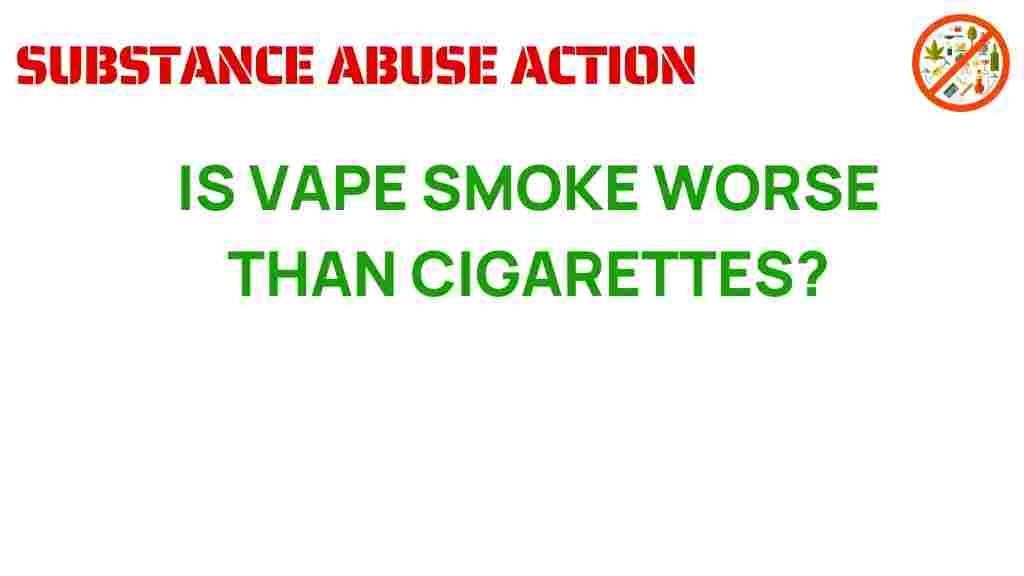Is Vape Smoke a Hidden Danger Worse Than Cigarettes?
In recent years, vaping has surged in popularity, particularly among young adults and teenagers. This trend has raised many questions about the health implications of vape smoke compared to traditional cigarettes. While e-cigarettes are often marketed as a safer alternative, evidence suggests that they may carry hidden dangers that could potentially be worse than traditional smoking. In this article, we will explore the health risks associated with vape smoke, its addictive properties, and the potential for lung damage, ultimately questioning whether vape smoke is indeed a hidden danger worse than cigarettes.
Understanding Vape Smoke and Its Composition
To fully assess the dangers of vape smoke, it is crucial to understand what it contains. Vape smoke, produced by e-cigarettes, comprises various chemicals, including:
- Nicotine: An addictive substance found in both cigarettes and e-cigarettes.
- Propylene glycol: A common base liquid that can cause respiratory irritation.
- Vegetable glycerin: Another base liquid that can produce harmful compounds when heated.
- Flavoring agents: Some of these can be toxic when inhaled.
- Formaldehyde: A known carcinogen that can form when e-liquids are heated to high temperatures.
Understanding these components is essential for recognizing the potential health risks associated with vape smoke compared to traditional cigarettes.
The Health Risks of Vape Smoke
When considering health risks, it is important to evaluate both short-term and long-term effects. The following sections outline the significant health risks associated with vape smoke:
Addiction
One of the most concerning aspects of vape smoke is its nicotine content. Nicotine is highly addictive, and e-cigarettes often deliver nicotine in concentrated forms. This can lead to:
- Increased consumption: Users may find themselves consuming more nicotine than they would from traditional cigarettes.
- Withdrawal symptoms: Users can experience cravings and withdrawal symptoms when they try to quit.
The addiction potential of vape smoke is significant, particularly among teenagers, who are more susceptible to developing dependencies.
Lung Damage
Lung damage is another critical concern when it comes to vaping. Studies have shown that inhaling vape smoke can lead to:
- Inflammation: Chronic inflammation can occur in the lungs, leading to respiratory issues.
- Popcorn lung: A condition caused by inhaling diacetyl, a flavoring agent that has been linked to serious lung disease.
- Reduced lung function: Long-term exposure to the chemicals in vape smoke can impair lung function, leading to chronic obstructive pulmonary disease (COPD) and other severe conditions.
These health risks highlight that vape smoke is not merely a benign alternative to cigarettes but may pose significant dangers to lung health.
Cigarettes vs. Vape Smoke: A Comparative Analysis
To better understand whether vape smoke is worse than cigarettes, we can conduct a comparative analysis based on various factors:
Toxicity
Both cigarettes and vape smoke contain toxic substances, but the nature and quantity of these substances can differ:
- Cigarettes: Release thousands of chemicals, including tar, carbon monoxide, and heavy metals.
- Vape smoke: Contains fewer chemicals overall but can still produce harmful substances, especially at high temperatures.
Long-term Effects
The long-term effects of vaping are still under research, but initial findings suggest:
- Cigarettes: Well-documented long-term effects include cancer, heart disease, and respiratory illnesses.
- Vape smoke: Emerging studies indicate potential long-term effects, but conclusive evidence is still being gathered.
Public Health Concerns
The rise of vaping has sparked public health debates. Some argue that e-cigarettes can help smokers quit, while others express concerns about youth vaping. Key points include:
- Smoking cessation: E-cigarettes may aid some smokers in quitting traditional cigarettes.
- Youth uptake: The appealing flavors and marketing strategies have led to increased use among adolescents.
Preventing the Hidden Dangers of Vape Smoke
Given the potential dangers of vape smoke, public health initiatives must focus on prevention. Strategies may include:
- Education: Informing the public, especially youth, about the risks of vaping and the addictive nature of nicotine.
- Regulation: Implementing stricter regulations on the sale and marketing of e-cigarettes.
- Smoking alternatives: Promoting proven smoking cessation methods such as nicotine replacement therapy and counseling.
By focusing on prevention, we can mitigate the health risks associated with both vape smoke and traditional cigarettes.
Troubleshooting Tips for Vape Users
If you currently use e-cigarettes and are concerned about the risks associated with vape smoke, here are some troubleshooting tips to consider:
- Monitor your usage: Keep track of how often you vape and the amount of nicotine you consume.
- Consider quitting: If you find yourself addicted to nicotine, seek resources to help you quit.
- Consult healthcare professionals: Talk to a doctor or addiction specialist about your vaping habits and potential health risks.
By taking these steps, you can better manage your health and make informed decisions about vaping.
Conclusion
In conclusion, while vape smoke may initially appear to be a safer alternative to traditional cigarettes, it carries its own set of hidden dangers that should not be overlooked. The health risks associated with vape smoke, including addiction, lung damage, and the potential for long-term health effects, raise significant concerns. It is essential for individuals and public health officials to remain vigilant about the dangers posed by both vaping and smoking.
Ultimately, the best course of action for those looking to quit smoking is to explore proven smoking cessation methods and avoid the allure of vaping as a smoking alternative. For more information on the risks associated with smoking and vaping, you can visit the CDC’s Smoking and Tobacco Use page.
Stay informed, stay healthy, and make choices that support your well-being.
This article is in the category Health and created by SubstanceAbuseAction Team
